Wowser….
Let me know if you need a relief man Bob… 
IDO » Forums » Hunting Forums » Deer Hunting » Tip of the Week
Kooty and I have gotten together on the idea of posting a “Tip” every week thru the beginning of November. The idea is to give some insight on strategies that I use/have used to locate, pattern, and harvest a Mature Buck. I also want to remind everyone that I’m not taking claim to all of them. I’m just passing along information that has worked for me. The tips will be coming out every Monday. (some will be more in-depth than others)
Tip #1: Write a “Thank You” letter to all landowners that allow you hunting access at the end of each season.
It’s easy to get caught up in the day to day routine of work, family, and friends. I’m like a lot of you and do not own any property. With that being said, remember it’s a privilege to hunt on private property, not a “right”.
Writing “Thank You Letters” is a must when hunting on other people’s property. Without their permission, you may not have a place to hunt or could be hunting on public property. Not to say it’s a bad thing to hunt on public ground, I’m just saying, it’s nice to have a place to hunt with limited pressure and competition from others.
Make sure you write out each “Thank You Letter” (don’t type or email). I like to include a picture of any animal that I harvest and tell a brief description. It’s also a good idea to include gift card for a local restaurant or gas station as well.
This is also a great way to lead into getting permission for the following season. When a landowner knows you respect them and their property, they are more likely to continue giving you permission.
This “Tip” is the easiest one that I will share and likely the most over-looked. Without permission to hunt on private ground, a lot of memories, thoughts, strategies would not exist.
Remember the landowners that do allow others to hunt on their property are not obligated to grant permission year in and year out.
Some of you know first-hand what it feels like to lose a spot to hunt (I know I do). Make sure to write out those “Thank You’s”.
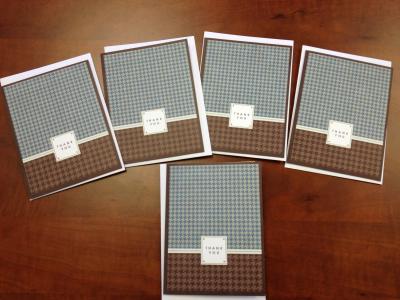
Awesome Idea IDO Staff.
Great First Tip too, perfect time of the year to do so.
Something often overlooked, yet extremely valuable.
Great tip, Gobbler! 
I too do this, I like to send mine put around the holidays wishing them a happy holiday and thanking them. 
We took it a step farther one year and brought the land owner everything needed to make a Christmas meal. Everything from the potatoes to a frozen turkey. That went over really well. 
Great Tip Ricco!
The one that I do is a thank u with a Christmas gift.. He seems to really like it. I dont think anyone can ever take for granted the property they hunt..Thinking,,oh I’m in for life. You just never know what can happen.
Tip 2: Deer Feed – Feed deer after season is over and where it’s legal
Every year when the deer season ends, I ask myself the same question; “What can I do in January-March to help keep bucks around the property I hunt for next fall?”
With the increasing competition from neighboring property food plots and/or deer leaving for wintering areas (which could be miles away) why would a deer stick around during the winter?
Only one property that I have permission to hunt could be considered a wintering area. All others lack good cover and offer very little food/browse for holding power. I know first-hand that it can be very difficult to manage deer from year to year when they winter miles away and do not return in the spring or summer. Really, I consider it lucky to see the same deer from one year to the next on most properties.
Here’s the deal. You know a few good bucks made it thru the season based on pictures from your cameras. It could be a good up n’ comer 2.5 yr old or a Monarch buck that is 5.5+ years old. Of course, you want to get your hands on one of them next fall. Here’s the question: What steps are you going to take to help put the odds in your favor come fall?
In my opinion, there isn’t a better time to put out deer feed then right after season. In Minnesota, it’s illegal to feed/bait deer between the beginning of Sept and the end of season (Dec. 31). With that said, come the 1st week of January, you will find me at the local feed mill buying 30 lb bags of deer mix to spread on my existing food plots.
“Why on the food plots? There’s already a food source there for the deer.” You may ask. I know and understand that but, my goal is to condition the local deer population that there will always be food source to eat in that area year round.
If you don’t have access to a local Feed Mill, you can always order deer mix/feed from a company like Nutra Deer. They have a product in pellet form that is perfect for this type of application. It’s called PRO ANTLER 20% Protein Pellet. This comes in 50 lb bags and only costs $16.99/bag. http://www.nutradeer.com/store/index.php?cPath=27
I personally didn’t start doing this until last winter (Jan-Mar. 12’) and can say it definitely helped keep deer around. In fact, one property in particular had deer on camera year round and I had 4-5 bucks consistently on camera thru early March. I have no doubt that it worked because before last winter, the latest that I ever had a deer on camera for that property was X-mas day. Basically, in past years, the deer left for 3-4 months before making their way back and most of the time, it wasn’t the same deer from the year before.
So, if you haven’t already? Consider putting out some type of food source for the deer in strategic locations after season has ended. After all, it can only help.
*Don’t forget to read and follow your local and state regulations for feeding deer. This tip is not intending for any illegal activity.
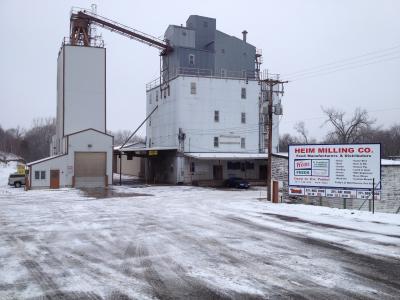
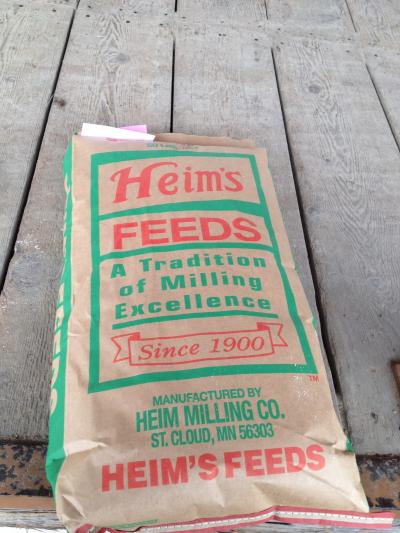
Tip 3: Sale/Clearance/Discount buys
This is the best time of year to buy product/gear for hunting!
Every year as archery opener approaches several Cabela’s, Gander Mountain, Sportsman’s Guide, and countless other ads or catalogs start showing up in the mail. It seems as though each company has something that catches my eye with the latest and greatest hunting apparel or gear. It could be new technology for game cameras, a new bow, or a new camouflage pattern. There is always something that I picture myself owning. The biggest issue with the arrival of new product is the cost. Right before season, the price for the latest and greatest is also the highest a consumer will see it all season.
This is where I have grown as a consumer over the years. What I used to think I wanted (not needed) was purchased at full price the day it hit the shelf. It didn’t matter to me that the price was higher and I even knew I was paying a premium because it was new on the market. I justified having it because, it was gonna help me connect on a mature buck.
The best example I have is for my 1st game camera. I can’t remember if it was 1999 or 2000 but, I paid $279.99 for a film Cuddeback. It’s funny because, I didn’t care about the cost or know anything about the company; I just had to have it.
Just mentioning the above makes me relive some very dumb buys. Over the years since I’ve started bow hunting, (2) things come to mind;
1. I have accumulated tons of latest and greatest (often over-priced).
2. I have learned to hold off on buying the newest stuff on the shelf at the beginning of season and wait to buy spendy items until after season when the price is reduced or on sale.
Like anything else, there is the risk of not getting something I want after the season. But, as with everything else, there isn’t a BBD guarantee with any product either.
This tip can go for just about anything that we buy for chasing game or catching fish. Plus, the best part about this tip….. Deer and fish don’t know that you bought your gear at a discount.
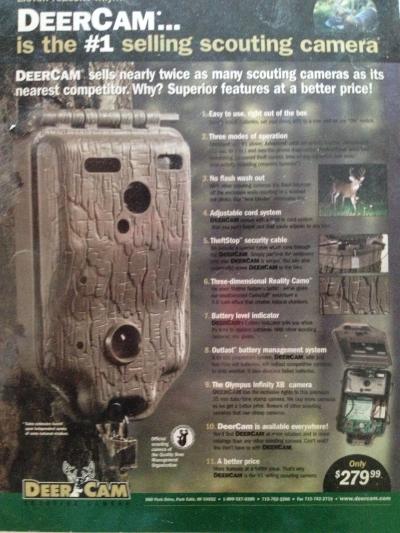
Tip 4: Game Cameras
With the price of game cameras today, I can’t think of any reason for not owning at least 1. Just looking at the different models, size options, and new technology, there is a camera that fits everyone’s style and budget.
I personally have 8 and it seems to be just right for me. It didn’t start out that way though. At first, I was happy to have one, then it grew to two, then I needed a couple more. After I had 4, I was like; “if I only had a couple more?” It’s taken a while (adding 1-2 per year) but, I can say with 100% certainty that having more than 1 camera is essential to locating, patterning, and harvesting a Mature Buck.
Since owning cameras, I have made tons of mistakes when setting them up. Below are a few of my favorites:
1.) Setting the camera at the incorrect height. I won’t forget setting the camera up only 1 foot off the ground and getting an entire roll of film that showed nothing but deer legs and bellies.
2.) Setting the camera at a 90 degree angle to the trail. This is and always will be a sure fire way for getting pics of the back-end of a deer. Nobody told me to set the camera at a 45 degree angle to the trail. (This will help maximize getting the entire deer in the photo)
3.) Checking the camera without new batteries, only to find that the current batteries are dead and I have nothing to replace them. (Imagine Homer Simpson….doah!!!!)
4.) Switching SD cards and forgetting to set the camera back on?? Yeah, I’m guilty of this more than once.
5.) My personal favorite. Checking the camera and getting the SD cards mixed up and bringing back the wrong one. Yeah, I’m guilty of this one too.
The above mistakes are examples that can make a big difference on the quality of pics that a person gets.
With so many different camera manufacturers on the market, which one is the best to choose? Even though I feel some brands are better than others, it’s really a matter of personal preference. I know that there are many great cameras to pick from but I only have used a couple different brands myself. Currently, I’m in the process of replacing some older cameras that are powered by “D” batteries. It’s not that they don’t work or take a good picture (I still love them for summer and early fall); I’m replacing them with new technology and cameras that run on “AA” Lithium Batteries. The battery life on the newer cameras that have hit the shelf during the past few years is amazing. Current models operate during the coldest weather of the winter, hold up to 32G SD memory cards, and are very user friendly. Some models are even capable of texting photos directly to your cell phone, while others can record HD video with sound.
When buying a game camera, I suggest looking at the following:
1.) Battery Life. The cameras that operate on “AA” batteries tend to have a longer battery life in the field and helps save $$ in the long run.
2.) SD Memory. New models on the market can support up to 32G SD memory cards or more. This is great for the cameras that are set-up on property that is several hours away. If you can’t check them all the time, this will give you peace of mind knowing that the camera is likely taking pics for months (under the right settings). Having a higher end SD card can also make a difference. Some SD cards improve camera performance (under certain formats) and even help to increase “trigger speed”.
3.) Still pics and video. This is where the newer cameras have really improved. The quality of video is better and the length of clips has grown. One thing to think about; it takes more memory on the video setting compared to still pics. If possible, put the camera on the setting that offers a still pic plus video. (kind of the best of both worlds). Plus, it’s fun to watch short clips of a buck making a rub or scrap.
4.) Flash or IR. This is personal preference. Some people like night pictures in color and others like black and white. The big debate is whether or not the flash “spooks” the deer?? Some manufacturer’s claim that the “flash” cameras take more juice from the battery too.
The above are just a few things to think about when buying a camera.
After you have decided on a specific camera, make sure to get a good understanding on the settings before placing it in the woods. This can be done in the basement or garage and is essential to getting good pictures the first time using it.
Once you have mastered your cameras, it becomes very addictive and can be just as rewarding as hunting. Some guys take placing cameras even further. By this I mean, placing them in strategic locations during different times of the year. Examples would be; facing cameras on field edges or mineral sites during the spring and early summer, pinch points or saddles during late summer and early fall, over scrapes and rub lines during pre-rut, and over feed/food plots during the winter.
Another part of owning game cameras is organizing pictures. An ideal way to do this is by creating a new folder for each buck in the “Pictures” library on your computer. Keeping track in a computer is simple and will help to identify each buck from year to year. I personally like to break it down by year, property, and name of each buck. Really, the possibilities are limitless.
What I’m basically writing here is, “don’t get frustrated.” It takes time to perfect “your” technique or set-up with game cameras. What works well for one person, might not work for another. I plan to visit this topic again throughout the year with set-up tips and strategies to pattern mature bucks.
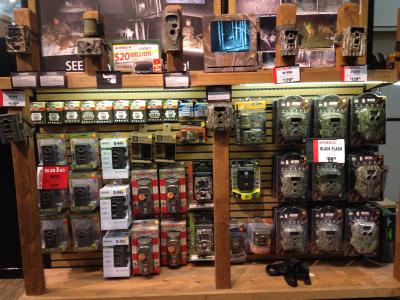
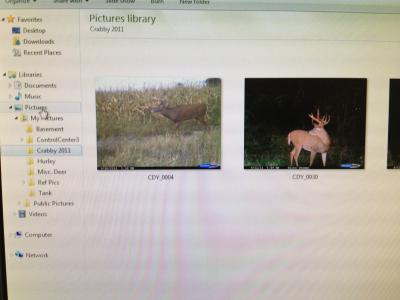
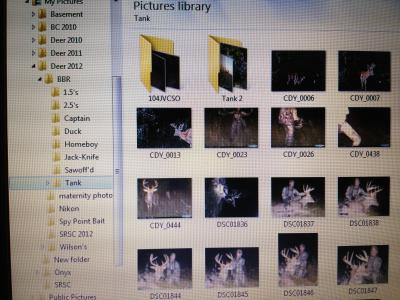
I would be interested in learning placement strategies for patterning bucks. Do you set up mulitple cameras in a 100-200 yard area or trail? Or just through out the woods on specific trails. We set them up through out the woods. But have never set up multiple camera’s in one section or trail. Just didn’t know if this would be a viable way to set up or not. Nice work on your tip of the week again.
Prieser-
Tip 18 & 25 involve more detail about set-up locations and patterning. Each buck will have certain habits that make them “killable”. It’s not an exact method that works for all but doing a little more leg work can help put the odds in your favor (any time of the year). I’ll try and time the “tips” as antler growth increases.
I don’t want to put my foot in my mouth…. I’m hoping 1 or 2 of the bucks will be around to show how I do it.
So your saying….Just hold your darn horses.  I’m looking forward to the rest of your tips. Thanks
I’m looking forward to the rest of your tips. Thanks
Tip 5: Looking for Sheds
When the temperatures start to rise in the end of February or early March, the itch to get back out into the woods grows by the day. It likely has to do with the increase of daylight or the peace and quiet that draws us to the woods. But, for many of us, it’s all about the shed antlers.
More often than not, looking for shed antlers can be a mental grind with little reward. However, if you do happen to come across the “holy grail” of a shed, it definitely makes up for all the time spent walking around searching with nothing to show for it. I personally have yet to find my first shed but then again, I don’t put in very much time looking either.
My expectations and intentions are very high the first time out each year when looking for sheds. I focus my efforts on properties I have permission to hunt and always have a “game plan” of my outing a few days in advance. Like you, I want to make the most of my day and cover as much ground as possible.
When shed hunting, I like to walk by different stand locations or areas where I hunt. I love getting a different view of the woods without foliage and leaves on the trees. It’s always good to get a different perspective of the deer movement on each property. I make sure to take notice of new trails, stand locations, and mark/clear out shooting lanes. There really isn’t a better time of year (than now) to get some of this “little stuff” out of the way for next fall. Plus, the added value of finding a shed or 2 makes the late winter early / spring outings even better.
When talking with other hunters about shed hunting, a lot of guys are surprised when I say; “I haven’t ever found one”. The reality (for me) is the properties I have permission to hunt typically don’t hold deer during the winter and since the bucks are not around when their antlers fall, it doesn’t make much sense to spend a lot of time shed hunting these areas.
I asked Walleyebuster5 for some input on this subject and he had the following to say:
Ricco, you definitely hit the basics and the most important aspects of shed hunting. It’s rare that deer winter in areas that you hunt during the fall (but of course it has to happen somewhere). That’s the biggest mistake that the occasional shed hunter will make as they choose where to search. Just because there’s deer on a property in the fall doesn’t mean that they will be there in the winter months when they shed their antlers.
I would add that you need a food source to be successful. That food source could be a cornfield, bean field, grasses or even new growth inside the woods. I like to rate my spots from 1-10. 10 being an area with food, bedding and a ton of “ice trails” as I call them. To increase your odds you need to be in an area with a lot of deer and it needs to show a lot of sign as well. If there isn’t 20+ deer in a given area, I won’t waste my time looking for sheds if that’s my #1 goal.
OH, and trail cams! Just this year I began setting up cameras in the winter and it has saved me a ton of time. It’s a huge advantage knowing when bucks shed their antlers and how aggressively I should be looking in these areas. This holds especially true when searching in January or early February.
The last thing I that want to do is stress out a good buck or bump him to a different area by looking for sheds that are still on his HEAD!! It’s a waiting game and timing has everything to do with it. Especially if you are hunting private property and nobody else is shed hunting it. I’d stress the use of trail cams much like you do in the summer and fall!
Good stuff Walleyebuster5. Thanks for the input!
Since, I consider myself a “novice” shed hunter; I’m suggesting everyone to read or re-read this post: http://www.idohunting.com/forum/showflat.php/Number/601355
On a side note, here’s a great question that someone asked me the other day;
What are the pros and cons of looking for shed antlers? I didn’t answer but it did get me thinking.
Tip 6: Plan for upcoming fall hunts – out of state – weekends away
The process for an out-of-state hunt can become overwhelming at times. There are so many important aspects to think about in advance. It could be months or even years before the hunt actually takes place and it’s difficult to consider all the possibilities ahead of time. Successful hunts in a different state or country will take hours of research and preparation. Remember, expectations of one hunter to the next can vary drastically. I have found that doing research and leg-work before the actual hunt, along with good communication between guides, fellow hunters, and local DNR/Fish & Game Officials, will minimize mistakes or mishaps and maximize efforts toward the hunt. If there is one thing I do know about hunting, you will either have a great, okay, or ugly experience.
Expectations: This is the first piece of the puzzle when planning a hunting trip. Do you plan on a guided or DIY hunt? Are you planning to hunt with a group or by yourself? If you do plan on hiring a guide, the prep time will decrease and the cost will go up. (It’s a trade-off, time or money?) How long do you plan on hunting?
Game: What animal do you want to hunt? Whitetail/mule deer, elk, antelope, caribou, bear, moose, turkey, ducks, geese, etc? Once you narrowed down the species of game you are after, the other parts of the puzzle will start to fit into place.
Cost: What are you looking to spend? The cost for each hunt will vary based on many different factors.
License fees (for example) will vary by hundreds of dollars from one state to another or by species. Some things to consider; Is the license available over-the-counter or is there a lottery involved? Does the state have a preference point system? Some states require 8-10 or more preference points before getting drawn. Is there a deadline to apply for the license? The states that don’t offer over-the-counter licenses for out-of-state hunters will require an application before a specific date or deadline. Each state will have different policies and regulations to follow. Most of the time a state will have all the information needed on their website. However, I personally like to call and verify information with the local DNR or Game & Fish Departments. By calling, I get the most accurate and up to date information. *Sometimes regulations change and it’s not in print.
Accommodations: Are you going to stay at a hunting lodge or hotel? Do you plan on camping? What will you need to have a comfortable hunt? If you are on a guided trip, you probably don’t have to worry about food and beverage. On the flip side for you DIY guys/gals, you will need to have everything planned out. This means, meals, beverages, sleeping arrangements, supplies for cooking, cleaning, and cost of fuel. (Just to name a few)
Travel/Transportation: Does your trip require flying or driving? If it does require flying, what regulations does the airline require for transporting firearms? If you are driving, look on the web for directions, call each state’s Department of Transportation to make sure there aren’t any major road construction projects that will affect your route. How long will it take to travel? Plan on arriving a day early. Arriving a day early will help to get a better idea or feel of what lies ahead.
Weapon: What type of weapon do you plan on using? Do you need to buy a new gun to get the adequate caliber, power, or range for the game you are after? The last thing any of us want is to wound an animal and not recover.
Where & When: What area of the country do you plan on hunting? Are you going to be in the mountains, on the plains, or in the desert? Each will have different factors for clothing requirements. What time of year are you planning to go? Early or late in the hunting season? The weather changes in certain parts of the country can be drastic at times. To pack appropriately, consider all of the extremes for the areas you will be in.
The Bottom Line: Make sure to utilize all of your resources when planning to hunt out-of-state and visualize the entirety of the hunt. Call friends; use the web, call the local DNR or Fish & Game. Call some of the local guides in that area. Get an idea of what to expect. Just the other day, I had a friend tell me; “if you shoot an Elk, be prepared to spend 2-3 days for recovery.” I didn’t follow what he meant at first. He went on to explain the process involved; “to haul the animal out in quarters, the potential terrain that needs to be navigated with meat strapped to your shoulders, and the burn in your legs alone will require a day or 2 of recovery. If you are not prepared to help others in your group, hire a guide. It’s not fair to the other members in your group, if you are not willing to help in their recovery.” He made some excellent points in a short statement. Most guys don’t consider the work involved to get the animal out and only think about the harvest and pictures. What he is saying is: Choose your hunting party wisely.
So, whether it’s week-long drop camp, a high dollar guided trip, or a weekend getaway at your favorite place to hunt. Remember, shooting an animal is only a small part of the “entire” process. By planning ahead, doing some research, and understanding expectations. You are increasing the likelihood of an enjoyable experience.
Tip 7: Aerial Maps/Photos
Just the words; “Aerial Maps” puts me in a mindset to explore any information or details I can find on the computer about hunting. Looking at property with aerial maps on a computer will help before, during, and after stepping foot on the property. Points of emphasis will include; existing, new/ leased, or public property.
My personal preferences are Google Earth or Bing Live Maps (under Bird’s Eye View). Most of my time is spent looking at properties that I have permission to hunt.
Existing properties with permission:
Typically, I wait until I get several pictures of a good buck before putting in a lot of time and effort to figure out buck’s routine. After confirming he’s a homebody, the first step is to consider his travel routes. The goal is to figure out his entry and exit to a food, water, or bedding areas. And there isn’t a better way to work this than looking from above on a computer.
Before getting overly excited and placing a tree stand, I will consider many variable. Some basic things to consider include; what time was the picture taken? Was it during the day where I could get a shot at this him during legal shooting light? Was it late at night? What direction did he come from? What direction is he heading? Was he going to eat, drink, or sleep? These are just a few factors that come to mind when getting a picture of a good buck.
The next step to consider is setting up additional trail cameras. If I know the property well, this isn’t an issue. However, if I don’t know the property very well or it’s a new piece all together, I will completely rely on Google Earth to figure out stand locations and camera set-ups before disrupting the property. The information from above is invaluable and saves tons of “leg work”. The best example to date that I have for doing this was last year before I shot Tank. Even though, Tank was being very consistent with his pattern leading into season, I had only hunted the property one other time the year before and didn’t want make a mistake on an opportunity to harvest him. My initial reaction was to head into the woods and look for the perfect tree to place a stand but, I couldn’t afford to do that because the “spot on the spot” was so close to a bedding area. So, I went to Google Earth and picked out the exact tree that I would set my stand in and it worked out perfectly. I elected a tree that would offer good cover and give me one shot between 30-40 yards. If it wasn’t for Google Earth and Bing Live Maps, I wouldn’t have set my stand up in that tree. I originally had planned on putting my stand in a different location about 100 yards away based on glassing from the road.
Looking at aerial maps also helped me to consider the entry and exit into this stand. I was able to use the landscape, tree lines, and even ditches along the road to execute entry and exit with minimal disturbance. Again, without aerial maps, this wouldn’t be possible. I cannot stress using aerial maps enough. Looking on the computer really gives you such an advantage. It’s an opportunity to walk the property without disturbing anything.
New Property (lease or buy):
I can’t think of a better way to look at a new piece of property then in the comfort of my house. Using aerial photos is a perfect way to scout a pc of property before leasing or buying. I’m pretty sure that most people will do a walk around and research before buying or leasing. Once you start looking at property from a computer, you will soon recognize different terrain, types of trees, or low land areas. I can’t count how many times that I’ve looked at something on an aerial map and didn’t realize it was there. I love looking for pinch points, bedding areas, water sources, food sources, saddles, and just about anything that would have to do with deer movement.
One major thing to consider for deer movement is to look at the neighbor’s property. Try to imagine the way deer relate to the neighbors and how they exit and enter the property that you have permission to hunt. A good example for this took place in 2010. I was hunting on a farm in Buffalo County, WI and we had several nice bucks that were either living on the farm or the surrounding properties. Basically, while I was home during the week 3.5 hours away, I would look at one particular ridge and follow the terrain where the property lines met. Well, I ended up spending more time looking at the neighbor’s property and figured if the deer were to come down the ridge it would be 1 of 2 ravines. So, with a 50/50 gamble, I moved my stand during the middle of the day Saturday Nov. 6th and ended up shooting a good buck we called Rocket the next morning. My move had paid off and it had everything to do with looking at aerial maps from home. Without aerial maps, I wouldn’t have ever made the move or shot Rocket.
Public Property:
Another great way to utilize aerial photos is for viewing public hunting grounds. I have spent countless hours looking over Interactive County Maps in several states to scout potential places to hunt. Using different county websites online has helped me locate some dynamite stand locations on public land without ever setting foot on the property. On the flip side, it has also helped me to eliminate even more property. The best thing that I have found with county maps is the information that they provide. I can get names of neighboring property owners and have even asked people for easier access to public ground. Although most of the time it doesn’t work. It can help to have a few names in your back pocket.
Utilizing aerial maps or photos is essential for consistently harvesting mature bucks year to year. In fact, in my opinion; “Aerial maps are 1 part of the BIG 3 for figuring out a Mature Buck.” I couldn’t imagine bow hunting without looking at the property from my computer. It would be similar to ice fishing without a Lake Map or flasher/locator. I love to strategize and explore every nook, angle, or option possible on a computer to put a Mature Buck down. I will warn you though; in order to be consistent with BBD year in and year out, using technology to figure out Mature Bucks is very addicting.
Where is your favorite place to hunt? This is a super easy question to answer for me. It’s on a computer.
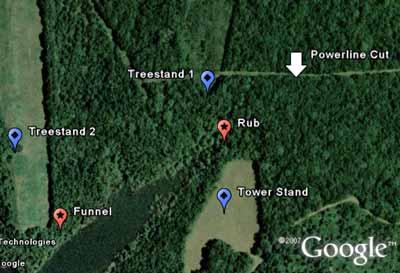
Tip 8: Organizing and storing your Hunting Gear
Process (defined); a systematic series of actions directed to some end
The hard part with hunting is being able to define the starting point or point in which hunting begins. I’m guessing that if I asked a group of 10 hunters; “When does the hunt start and end?” I would likely get 10 different answers for a starting point.
There’s no doubt that having a “process” has helped me grow as a hunter. I used to just throw my hunting clothes into the back of my truck or in the corner of the garage. I didn’t realize it was such a big deal to keep my hunting stuff scent free when not in use.
For me the beginning starts in the laundry room. I always get a kick out of my wife’s reaction when I tell her; “Honey, you can’t do laundry for the next couple of days, I started my process.” She usually responds by telling me how dumb I sound and my process doesn’t work…. LOL. “Oh well” I say to myself. My “process” includes 10-12 loads of scent free laundry. The loads include anything that I may be wearing while hunting. Don’t forget to double rinse every load either. After, I will put in the dryer or hang outside, depending on the weather.
*One point when hanging clothes outside. Make sure to hang your clothes inside-out. This will reduce the sun’s affect to fade your hunting clothes and you will get longer life or use out of them.
After washing, my clothes go in 1 of 3 different Rubbermaid containers. Two of the containers are for clothes that haven’t been worn and 1 container is for late season hunting jackets, bibs, etc. Once I have soiled a base layer or under garment, I will put the dirty stuff in a laundry basket placed in the garage. I will wash the dirty clothes on a later date and do a “mini” process with just towels, socks, t-shirts and base layers.
The “process” doesn’t stop with hunting clothes. It gets carried over to other gear like my bow, arrows, release, broadheads, etc. Each item gets stored or placed in a specific area where I won’t lose it. One of my favorite ways to store items is in a Plano box. The little boxes are ideal for holding field tips, mole skin, allen wrenches, replacement blades, etc. just to name a few items. The added bonus with Plano boxes is they are easy to store.
Then you have your tree stands, pegs, climbing sticks, straps, etc. Where does all of that get stored? If you are like me and pull all of your stands down after season, it can be a lot of work trying to figure out where to store everything. I like to hang stands in the garage and built shelving to hold onto smaller items and containers. It also helps to mark the outside of a box or container when storing for easy identification.
Proper storage and organization of your hunting gear can make a difference when it comes to shooting a deer. For most hunters, our hunting stuff is in storage for longer periods of time than in the field. We need to make sure we keep it all organized from the start of the hunting process to the finish. In-fact storing your gear is probably more important than hunting in your gear. Remember, having a “process” or plan in place helps to build confidence and decreases the little mishaps that we can control.
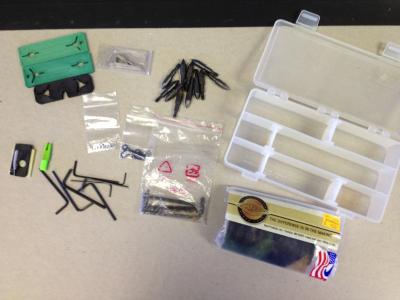
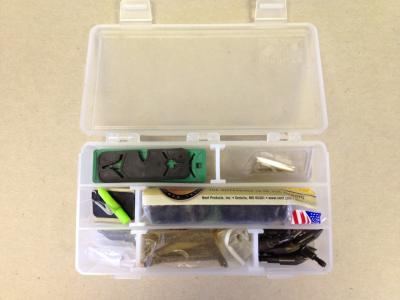
Tip 9: Inventory and Supplies
April is the perfect time to inventory hunting supplies. I personally like to make a list of things at the end of each deer hunting season of things that I’m running low on. That way, I don’t scratch my head a couple days before opener (the following fall) and run around from archery shop to outdoors store looking for what I need?
With Spring Turkey season just getting started, it gives us hunters another opportunity or excuse (if that’s what you want to call it) to hit the woods and chase some game. It also gives us a an idea of what items we need to replenish, replace, or stock up on to be successful in the field.
I know taking inventory of your hunting supplies is an easy task and this isn’t much of a tip. This is more just filling the gap and staying busy when things are slow in the deer world. But, taking the time to buy/stock up on supplies now will pay dividends later on as deer season approaches. Remember; before we know it, other objectives like placing stands, shooting our bows, prepping food plots, and fishing will soon outweigh spending time running around town grabbing last minute items for hunting.
Once again, another great tip Rico!!! Thanks so much for keeping up with this! 
I’d say it’s a very valuable Tip Ricco! We’ve all been there running around town to each spot only to find out there’s none left or you end up settling for something less than what you really needed. 
Tip 10: Clear woods, debris, or trees and make piles/lines. Do this before the weather is warm and underbrush and leaves grow
When is the best time to go after a Mature Buck? Pretty good question, huh? Well, we all know that nobody has a perfect answer for this but; I can tell you “The best time to hunt a Mature Buck is when the wind direction is at his advantage, not yours.” So, how can we battle this obstacle? Many times my solutions start by making a “Brush Fence.”
Making a “Brush Fence” is one of my all-time favorite ways to put deer within bow range. I still remember the first time I put this strategy to the test in 1999. I had just read an article about using dead tree limbs and X-mas trees for blocking specific deer trails. Basically, the article said “try to eliminate trail options for deer and push their movements toward your stand location.”
At the time, I was willing to do anything to increase the odds for shooting a Mature Buck. So, with this new information, I went down to my favorite hunting spot and stand location and started making a brush pile wall that turned out to be 42 yards long, 4-6’ wide, and 5-6’ tall. I even sweetened the pot by making the end of the “Brush Fence” extend over an 8’ drop-off of river bank. Since the woods was only 70 yards wide, every deer that walked along the river ended up walking within 15 yards of my location or out onto my food plot for a 15-40 yard shot. It was an amazing set-up.
The first step (when applying this strategy) is to look at the terrain. Ideally, one of the following is needed; existing fallen trees, field edges, and steep ravines or river banks. Another advantage is to know how deer move in the area.
Field Edges: (There are 2 applications for Field Edges) The first way is by looking for fallen trees that are 30-40 yards off the field edge and plan from there. Let’s say (for example) my tree stand is 15 yards off of the field edge and 20 yards from the fallen tree. I will make a “Brush Fence” extend off of the fallen tree (away from my stand). I try to cut off all existing trails out to 40 yards from my stand. If you can, leave an opening at 40 yards and then continue the “Brush Fence” out to 70-80 yards. Obviously, the idea is to force or have a deer walk within bow range and you will know when and where your shooting options/distances are in advance. The deer will either walk between you and the tip of the tree (20 yards), through the opening (40 yards), or out of range.
The second way is to block entry and exit points onto field edges. This can be deadly when sitting on the edge of a food plot. Start by picking your stand location and make the “Brush Fence” along the field edge. This will force deer to specific locations that have been pre-determined and it won’t take long for the deer to adapt.
Woods: The same can be done in the big woods as with field edges. Look for a couple of fallen trees (30-40 yards apart) in a prime location and place your stand between the 2. Repeat the process of piling brush and dead tree limbs on both sides of the stand. Hopefully any deer moving within a 150-160 yards of your stand will walk through one of the (2) openings at 40 yards or within your 30-40 yards radius.
Steep Ravine/River Bank: This strategy can really pay off when using a steep bank or drop-off. I have noticed from personal hunting experiences that deer like to take the easy route. Knowing this, I will build brush piles 10-20 yards off of the tip of a ravine to push deer toward the secondary trails. Since deer don’t like to be in a position where they cannot see what’s going on around them. More often than not, they will walk on the high side of the “Brush Fence”
Here are a few key things that come with making “Brush Fences”:
Deer movement: You may not notice a lot of change the 1st year but, after a year or 2, you will notice that the deer have adapted to the brush and use the paths that you created.
Wind direction: (This is probably the #1 reason for this tip) So, you have the perfect spot that doesn’t set up well for a certain wind direction? Make a “Brush Fence” in that area so you can hunt under conditions that will put you at an advantage, not the deer.
Clean up the woods: It’s fun to get out and clear debris and strategize on the ground level. Plus, knowing the deer movement beforehand will give you an advantage and elevates confidence while in stand.
I know making a “Brush Fence” isn’t the perfect answer to this question. However, when implemented correctly, it’s something we can do as hunters to tip the odds in our favor when trying to harvest a Mature Buck.
*PS Don’t forget to bring gloves and a hand saw to cut small limbs

Tip 11: Turkey Hunt – chase a long beard or two
If you haven’t been out Spring Turkey Hunting before, what are you waiting for? Even if you don’t get into it like deer hunting, you owe it to yourself to have another excuse to be in the woods.
I’ve shot my fair share of Long Beards over the past 10 years and admit that it can be very challenging to give a Big Ol’ Tom a dirt nap. Even though hunting turkeys is different than hunting deer, it does give similar challenges. Pretty sure that is why I like it so much.
Chasing turkeys also gives me a chance to freshen up mineral sites and set cameras for deer. I may even take time to clear some debris or fallen trees off a field edge. Not that I want to put a lot of time and energy into prepping for deer during turkey season. It just gives me an opportunity to get away from the hustle and bustle of work, family, and other obligation. Basically, that much needed time to get some of the little things out of the way for next fall.
Ultimately, the outcome of harvesting a Long Beard will bring the same type of adrenaline and emotion that shooting a deer will. I highly suggest that you go out and chase some turkeys (especially if you haven’t done it before) and think about deer hunting while out in the field. It’s a great time to start preparing and visualizing for deer this fall.
Who knows, you might even find a shed.

Tip 12: Consider food plot options
Planting a food plot involves more thought than turning soil, spreading some seed, and watching it grow. Just because you have an open area on your property and it looks like the perfect location for a food plot doesn’t mean that it’s the right location. I’m not saying “it’s not the perfect location”; I’m just saying “there are several major objectives to consider before picking a location for a food plot.” Examples include; Sunlight & Shadows, prevailing winds, evening or morning hunts, exit or entry into the stand, seed, bedding areas, watering options, and existing trees.
It seems like yesterday when I planted my first food plot. It was a small area (roughly 1.5 acres in size) along the woods and was the perfect spot in my mind. I didn’t put any thought into why it was the perfect spot except that it was an area of the property that the land owner didn’t plant and it didn’t harm his crops. I had hired the neighboring farmer’s kid to chisel plow and disc the area. When he finished turning the soil, I checked the pH level to see if I needed to lime or fertilize. Luckily it fell into the correct range on the pH scale for the clover I was going to plant and I was able to save time and money by skipping that step of the process. So, I asked a friend to use his 3 wheeler for dragging an old spring mattress around the area to smooth things out before spreading seed.
Making my first food plot was a very simple idea without much thought process. I chose the spot because it was available and wouldn’t take much work to turn the ground and spread seed. After the work was done I just prayed for rain. I didn’t have any clue what I was doing yet, the results were amazing.
Since my first food plot, I have planted one other food plot on the same property and have helped several friends with planting food plots on their properties. Over the past few years, I have used a different approach in determining where to plant compared to the “keep it simple stupid” approach from my first attempt.
The first thing to consider before the whole process begins with a new food plot is where the stand locations will be. Personally, I am not a big fan of hunting on the edge of a food plot. Instead, I prefer to hunt the transition areas to and from the food plot. I have several reasons for my method based on previous hunting experience;
1. I don’t want to get stuck in my stand when deer decide to feed after dark
2. In the transition area, I’m able to be enter and exit my stand location with little disturbance
3. Mature bucks typically don’t show up on my food plots during legal shooting hours
The second thing to consider is entry and exit routes into the stand. The idea is to minimize any disturbances and keep my presence unnoticed. Having a stand on the edge of a food plot can be hard to enter and exit without bumping or pushing deer.
The Third thing to consider is which wind directions are optimal for my stand location. Believe it or not, during the early part of the archery season, I will hunt a stand when the wind direction is not in my favor. I only do this if (THAT’S A BIG IF) I have determined that the stand location is in “the spot on the spot” and I have no other alternative. Keep in mind that you will likely only get one chance at the buck when doing this so, make it count.
Other very important things to consider are where the deer are bedding and getting water. Bedding and water really determine where the “transition zone” is and cannot be over-looked.
Think about the location that you have picked and why it’s the perfect spot. Ask yourself a few simple questions like; Does it offer the ideal situation for hunting? Will you be able to get in and out of your stand undetected? Will the Sun be in your face or at your back during the hunt? Which wind direction will be in your favor? Where are the deer bedding? Where are the deer getting water? Do I have to clear trees in order to plant? Is it too close to a known bedding area? There are several other questions to go along with these.
Again, all of the different variables that I’m mentioning need to be addressed before breaking ground for a food plot. I know first-hand the time and effort that goes into planning a food plot can drive a guy crazy. In fact, just thinking about some of the obstacles like soil prep, proper pH levels, optimal seed depth, and constantly fighting weeds gets me exhausted. However, that really isn’t the stuff that matters. We need to think about deer habits and how they will use the food plot. Consider your location based on all aspects of the hunt, not just because it’s open area that looks good and will be easy to plant.
Tip 13: Mineral Sites & Application
Goal: the result or achievement toward which effort is directed; aim; end.
Without a doubt, mineral sites help me achieve my #1 goal before season opens. That goal is to locate and pattern a Mature Buck. Currently, I have 5 different properties that I put mineral on and maintain until late July. Once I have determined that there either is or isn’t a shooter running around is when I make adjustments.
In the past week I’ve really noticed a shift in deer movement. It seems that spring has finally arrived and the deer have begun to break out of their wintering areas and started heading to their summer haunts. Most of the deer are in search of any available food source to help nourish the lost reserve from the long winter and most movement seems to take place during the last hours of the day.
Some things I look for when putting out mineral are high traffic areas, cover, water source, and slight incline/decline. I realize that we can’t always have all of the fore mentioned but if you have a couple, it will help.
There really isn’t a secret trick to getting a mineral site started or keeping it maintained. The first step that I take is to look at Local & State Game Regulations. Some states have different policies and regulations that must be followed and the last thing we need is to get in trouble for good intentions.
When:
If you haven’t already started or replenished existing mineral sites, I suggest getting them up and running immediately. This time of year deer can use all the help they can get when it comes to mineral supplements. With little food source, foliage, and browse available, it can be tough for them to gain back the valuable nutrients they lost during the winter.
Where:
Next, I determine where the sites will be by looking at aerial photos/maps on the computer. I will place my locations based on major trails, food, water, and bedding areas. I don’t want to throw out any area because it doesn’t have something I’m looking for; it’s more of a guideline to help determine one place over the other. (You never know where a shooter may be hanging out??)
What:
After I have decided where, the next step is to figure out what I’m going to put down. I like to make my own mix by breaking up Mineral Block with a mull-hammer to almost “sand like” size. I do this for a couple of reasons. One, it’s easy to keep in a 5 gallon bucket. Two, it’s easy to mix with other product.
Once, I have my mineral “hammered out”, I like to add Deer Cane and shell corn. The Deer Cane helps for smell and the corn helps to draw deer in. It seems that each location is used differently and some deer like the mineral, others just like the corn, and other sites the deer don’t hit at all. This way I cover my bases and get deer looking for mineral or an easy meal.
Why:
For me it started by talking with fellow IDOer’s and looking at Nutra Deer. Basically, I was looking at the Nutra Deer website (www.nutradeer.com) and asking others what worked best for them when applying mineral supplements. It seemed that each person had their own reasons but across the board there was (2) similar objectives.
1.) To help the deer get a jump start on nutrition in the spring.
2.) To get pictures of all the bucks in the area that made it from the previous hunting season.
*The 2nd objective is really what drove me to make mineral sites.
Eliminating properties sucks because of the history we have with them producing in the past. I’ve had to eliminate properties for early season several times over the past couple of years. I’ll be the first to admit; “it’s hard to move on when a (go to) property isn’t holding a good buck.” We want to believe that a shooter will magically show up but, the reality is a shooter may not show up all season and we can’t afford to waste time hunting where we can’t confirm a Mature Buck is living. I personally will pull cameras off a property if I’m not getting pictures of Mature Buck. On the plus side of things however, knowing that a Mature Buck is hanging around a different piece of property helps ease the pain.
To sum things up, making mineral sites is a proactive approach for locating Mature Bucks and helps us narrow down which properties to focus our efforts on once season starts. So, pick a location or two and get your mineral site started. After all, it can’t hurt.

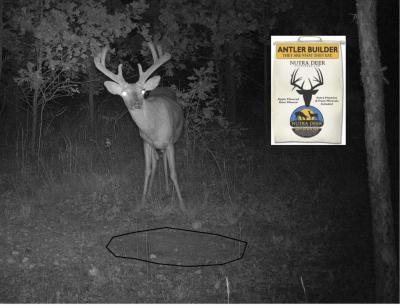
Tip 14: Start prepping for food plots
If you haven’t already started prepping your spring food plot, this needs to be addressed ASAP. Proper preparation of soil on a food plot bed can make a world of difference on how well the final product turns out come fall. I’m hoping most of you are ahead of the game and already started or completed your spring food plot. But, for those of you that haven’t; here are a few last minute tips to help.
Make sure to kill the existing plants. Whether it’s weeds or food plot re-growth from years past, make sure you either do a controlled burn or spray some type of weed killer to get rid of any unwanted competition before planting new seed.
After spraying/burning, make sure to follow the manufacturer’s recommended wait time before planting. It’s also a good idea to use a drag (of some type) to pull all of the dead grasses out of the area before spreading seed.
If you want to maximize your results, make sure to take a look at the pH level of the soil. Planting a seed that fits the existing pH level of the soil or using fertilizer and lime to get the proper pH level of the soil is a major piece of the puzzle. Remember, if you can’t fertilize or lime, certain seed types will do better than others in different soils. Do a little research online and figure out what would work best for your soil type and pH level.
If possible, disc or till the soil. If you have your own tractor with disc or tiller, you have it going on and are fortunate to be able to do all of these steps on your schedule. For those who don’t (me included), we will either need to lean on some friends who do, pay a local contact to do it, or rent from an equipment rental facility.
Spreading. When using a walk-behind or handheld broadcaster, make sure to adjust the opening to the seed size recommendations. I prefer the walk-behind because when I use the handheld, it feels like I’m reeling in a fish that won’t come in and my hands start to ache. (Some of you know what I’m talking about)
After the seed has been spread, we will need to likely compact/roll it. This can be done several ways. The first is using a small pull behind roller/compactor with attachment for a tractor or four-wheeler. Another way is to just drive over the top with a four-wheeler or truck back and forth using the tires as the compactor. Having the proper seed depth will make all the difference on germination and can be the difference between okay, good, or great results. Don’t skip this step.
Water (if possible). Take a look at the forecast before spreading seed and make sure there is a good chance of rain for a day or 2 after spreading the seed. This will help “jump start” the seed by giving it much need moisture in the soil.
When it comes to food plot success, there is no doubt that getting rid of weeds/plants, checking the existing pH levels, and using a tiller or disc before applying seed is the best route to take for desired results. If necessary, do some research online for recommended applications of fertilizer and lime amounts. Once all the prep work has been completed, take a look at the forecast (if possible) and wait to spread seed and compact/roll before an upcoming rain. Having the proper seed depth along with moisture should top off the final touches of a great food plot.
Remember to check out the: Food Plot and Wildlife Habitat Forum if you have additional questions
Tip 15: Seed Type – Annuals or Permennials?
The sense of promise and excitement that comes from a freshly tilled or disc’d section of land is one of those “simple things in life”. There’s something to be said about turning soil, prepping the seed bed, planting seed, and watching plants grow. Add the idea that a Mature Buck might be frequenting your new food plot throughout the year and we have created a recipe that dreams are made of. The big question now becomes; “What seed type am I going to plant? Annual or Perennial?”
Annuals:
Annuals are plants that only have 1 growing season and will not grow the following year. Good examples of Annuals are Corn and Beans. Annuals need to be planted each spring and have some pros and cons.
Pros:
– Can be very effective for late season when all other crops have been harvested.
– Contains high amounts of protein and carbohydrates to help deer pack on the fatty reserves for winter
– Produces more tonnage of eatable mass for deer during hunting season
– Don’t need to be mowed
Cons:
– Needs to be planted every year and the soil prep work will require all the steps to be repeated
– Needs to be harvested or cut down at some point (adding another step with machinery)
Perennials:
Perennials are plants that can grow for 2 or more seasons. Good examples of Perennials are Clover, Alfalfa, and Oats. Perennials don’t need to be planted each spring and have some pros and cons.
Pros:
– When planted from the year before are a nice food source for an early start after a long winter
– Can last 3-5 years
Cons:
– May require mowing/cutting if they grow to higher then desired levels
– Doesn’t carry the nutrients like perennials
– Likely will involve multiple trips to spray herbicide in order to control competing weed growth
In a perfect world we would be able to get the best of both worlds and have an Annual that could produce for a few years like a Perennial. Since we can’t keep the “Pros” and get rid of the “Cons” for each, consider dividing your food plot into 2 sides or create 2 separate food plots and plant both. It may take additional time, effort, and $$ to get this done but remember, you can’t put a price tag on a Mature Buck.
Tip 16: Create Trails
Creating trails for deer to pass by your stand locations can be a very effective way to get more shot opportunities. Whether you create deer trails in the woods, CRP, or crop land there is an application for each hunting location. They include a brush hog, brush mower, walk behind mower, hand saw, or even herbicides like Round Up.
My personal favorite way to make trails is renting a walk-behind DR Field Brush Mower. I have been renting a Brush Mower for the past 3 years in the middle of August and can’t say enough good things about the results. I have used the Brush Mower for cutting paths through CRP, cutting down over-grown weeds in a food plot, and also for making paths through the woods. Each use or application has been very successful in its own way.
Before making the trails/paths, remember to have some purpose behind what you are doing. The first thing to determine is your stand location? After you have picked the “spot on the spot” for your stand, determine where the shot location will be? This can be in the woods, along a field, or going into our out of a known bedding area. After you have thought about the deer movement and which directions you would anticipate them moving, do a little walk through before cutting anything.
Once you start cutting, make sure to not overdue the trails or make more than you need to. I like to only make one pass by each stand location. I do this for a couple of reasons. One, it gives the deer an easy path to walk on. Secondly, the trail should put the deer in a vulnerable position for making the shot.
*The best results come from making a big “X” or “Y” and have the main crossing run 20 yards past the stand location on the North side (if possible)
This same “concept” can be achieved at different levels by either using a regular walk behind mower or Brush Hog type attachment for a Skid Loader/Tractor. If you want to even put a little elbow grease into the tip, you can use a hand saw to cut lower tree branches or spray herbicide on underbrush to clear paths through some thickets. If you can, try to utilize this tactic with Tip 10.
* Included pictures from 2011 using this tip
1. Brush Mower (center of the “Y”)
2. Crabby (using the trail)
3. Harvest (shot Crabby at the top right tip of a “Y” trail set up)
Why is there an advantage to placing it on the north side? Is there any reason to wait until August? Thank you for keeping this up Gobbler 
 ! Every single tip of yours in some way motivates or triggers ideas for me.
! Every single tip of yours in some way motivates or triggers ideas for me. 
todders-
Good questions. The reason for cutting the trail on the N side has to do with prevailing winds during the fall. In my experience, the majority of the time in late Oct. and early Nov. there is a N/NW wind and having the trail on the N side of the stand will increase the odds for deer walking/passing by up-wind.
As for waiting until Aug? I prefer to cut trails mid to late August because the growing season for most of the weeds and leaves is pretty much done for the year.. This way the trails won’t need to be cut again before or during season (helping keep scent to a minimum).
You must be logged in to reply to this topic.